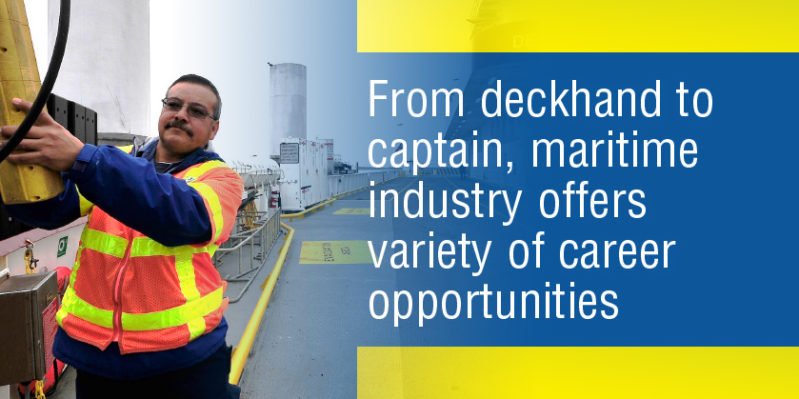
When José Tamayo and Calvin Aubry step foot onto the deck of the Galveston Island Ferry, they can be in for a long day as deckhands. But as they both see it, what’s better than a day on the water?
The deckhand is the first position for a person vying for a chance to work in the maritime industry. It is a position that opens doors as mariners continue to obtain their U.S. Coast Guard (USCG) certifications. As keeper of the deck, deckhands are usually in charge of some maintenance duties, loading and unloading, and keeping the deck in order.
They can start making anywhere from $130 to $170 a day, depending on inland or near coastal service. For deckhands who work on the Galveston Island Ferry, the job allows them the ability to return home each evening after working eight-hour shifts.
“What I enjoy about this job is that I get to see a lot of people, work outside and on the water,” said Aubry, who has obtained five certifications through training in the San Jacinto College maritime program. “I was willing to start work at the bottom and am taking the necessary steps to move up the career ladder.”
Aubry has completed USCG-approved certification courses in lifeboat operations, CPR, first aid, and firefighting at San Jacinto College. Tamayo, a fellow deckhand, said the endorsements and certifications are what move a person up in his or her job.
“There is a lot of room for advancements. It didn’t take me long to advancement from a level 3 deckhand to a level 1,” said Tamayo, who has worked on the ferry since 1990.
Both Tamayo and Aubry plan to move up to able-bodied seaman in the coming years. After advancing, they’ll continue to train for positions as mate and then captain. That’s what Capt. Johnny Smith did, taking a journey that many have made over the years at the Galveston Island Ferry.
As master of the ship, the captain is a maritime position loaded with responsibilities of overseeing all other positions, as well as navigation and overall safety of the passengers and crewmembers. It’s a title that Smith has spent years training and working his way up to receive.
“I started at the ferry in the summer of 1989 as a deckhand, and then earned additional certifications to promote to able-bodied seaman, and mate and then applied for captain, master of a motor vessel, 1,600 ton or greater,” said Smith, who got his start in the maritime industry as a deckhand in 1985 working on a private excursion vessel.
Smith is in charge of navigation, supervision of the crew, delegation of daily duties, safety rules and regulations, keeping a deck log, and communication with passengers. A captain’s pay varies, starting at approximately $4,000 a month in Galveston and increasing with years on the job. Captains who work offshore will make more money due to higher demand for work hours, spending weeks or months away from home, and different responsibilities of the job according to the industry.
“Working in the maritime industry takes a positive person, who wants to work and move his or her way up the career ladder,” said Smith.
For information in training in maritime, visit www.sanjac.edu/maritime.
Jeannie Peng-Armao


